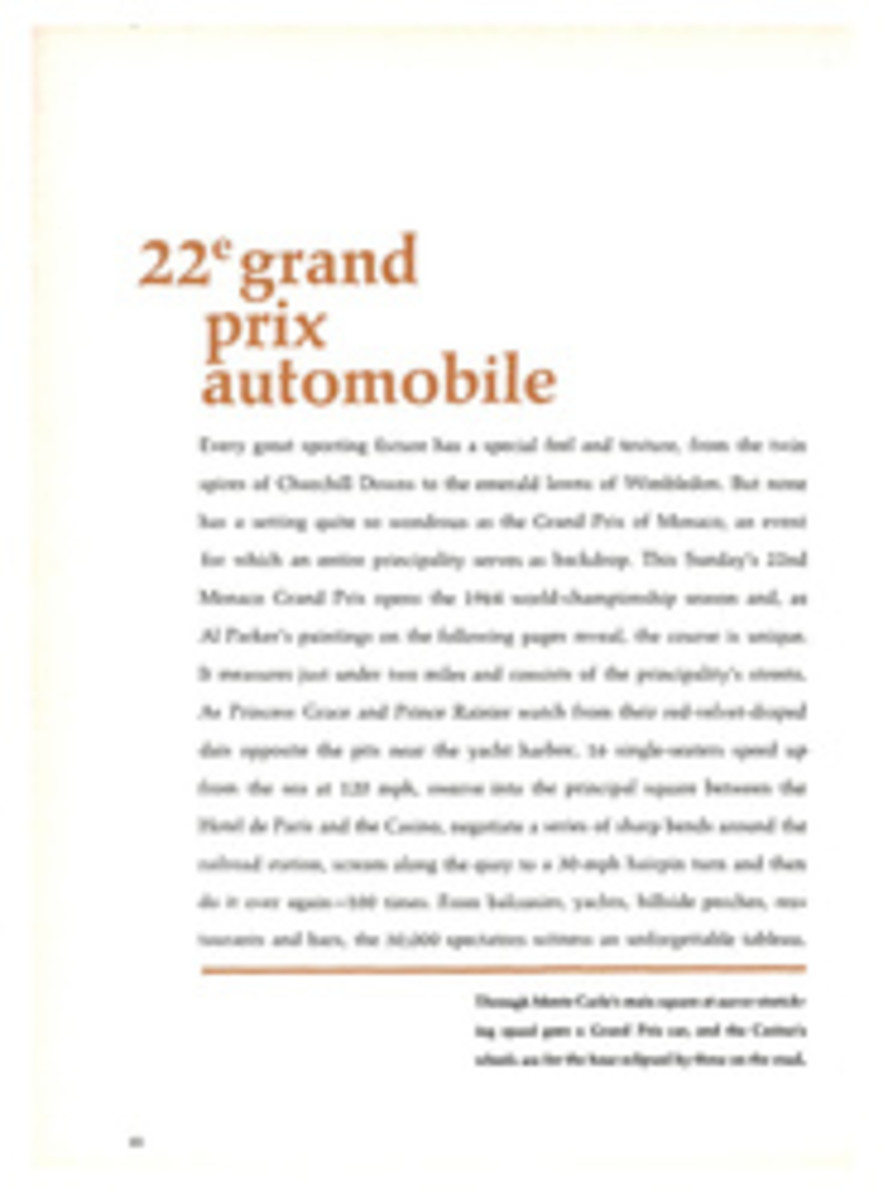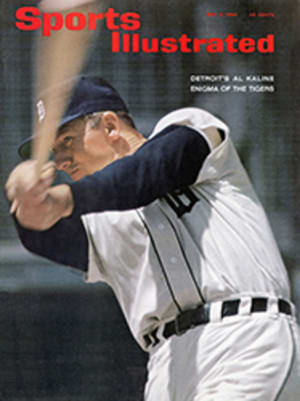
Ford's up, Jaguar's on deck, Mercedes aims to play
International road racing is on the verge of a battle of giants in which famous firms will spend huge sums of money to dramatize their showroom motor cars in world markets. Ford Motor Company has already declared in. Jaguar of England, five times winner of the 24-hour race at Le Mans, will return to the great French event next year after being absent eight years. And when Jaguar returns, Daimler-Benz of Germany, the most renowned name in racing history, will almost certainly come back as well with its silver Mercedes cars.
Looking further ahead, I believe that the impending entry of Japan into Grand Prix racing may well force these Western companies to participate in Formula I as well. While the Le Mans-style prototype and Grand Touring cars that have evolved from what we used to think of as sports cars are indeed important, they cannot approach full-scale Formula I Grand Prix cars for national prestige. The world of commerce cannot overlook the impact made on international markets by the Japanese, with their transistor radios, tape recorders, cameras, binoculars and motorcycles; and now the decision of the big Honda company to compete in Formula I poses a serious threat to all who manufacture passenger cars.
This is the situation, then, as Ford prepares a trio of 200-mph prototype racers for Le Mans. For many years European manufacturers refused to take American products seriously in international motor racing. Ford has changed that with its successes in the Monte Carlo rally, in which a Falcon has won the special stages for two consecutive years; at Indianapolis with the Lotus-Fords; and most recently at Sebring, where its engines powered the Cobras that shattered Ferrari's supremacy in GT racing.
Now the vast Ford empire seeks to topple the red cars of Maranello from their present lofty position as world champions in both the prototype and GT categories. The prototypes are the most glamorous and yield the largest publicity dividends. Ford wants that publicity. To that end, it has acquired a clever prototype design from the Englishman Eric Broadley—the Lola—and developed it in Dearborn and in the Slough factory where Broadley builds his sports and formula cars. A team of technicians was brought over to Slough from the U.S., mechanics were engaged and ex-Aston Martin racing-team manager John Wyer was put in charge. Taking advantage of new tools, Ford has used electronic computers in the prototype's development. Experimental data is collected by Ford Engineers Roy Lunn and Ron Martin and fed into machines in Dearborn for application to the work in progress at Slough. Rather confusingly called GTs, the cars are powered by the lightweight aluminum V-8s that ran so strongly and reliably last year at Indianapolis.
Ford discovered the other day in trials at Le Mans that sophisticated engineering is not in itself enough to make a winner. Two prototypes appeared, and they both crashed, after displaying a tendency to get airborne at high speed. Detecting such bugs is the reason for trials. Ford should have things sorted out by the time the flag falls at Le Mans on June 20.
While Jaguar and Mercedes work strenuously behind closed doors on their own solutions to this invasion, Ferrari is also paying strict and overt attention. Ferrari's position in racing is vitally important to the Italian automotive industry. The giant Fiat concern has provided Commendatore Enzo Ferrari with hundreds of thousands of dollars to insure that he continues racing, realizing that Ferrari victories are Italian successes and that a share of the glory seeps down even to the tiniest Fiat.
Earlier, when Lancia abandoned its ambitious racing program following the death of Driver Alberto Ascari in 1955, the entire project, including Grand Prix cars, machine tools and many spare parts, was handed over to Ferrari. Additionally, Fiat chipped in with a quarter of a million dollars. At the time Italy was in none too happy a state as regards racing. Mercedes' all-conquering silver cars had whacked the finest Ferraris. Maserati was in the doldrums, and another famed Italian racing firm, Alfa Romeo, had already quit the circuits. The prestige of the Italian industry was left in Enzo Ferrari's hands. It was not misplaced.
But Ferrari is a small outfit, producing only a few hundred ultra-expensive nonracing cars a year to be sold to the public. It is therefore not in direct commercial competition with the large European manufacturers. The challenge from Ford is quite a different matter. Ford owns large factories in England and Germany whose production competes head on with European cars. There can be no doubt that international racing successes won by Ford must confer sex appeal and sales appeal on its European lines. One must remember also that Jaguar and Mercedes have an extremely profitable market for their cars in America—a market gained in no small measure from racing prestige.
If America now creates a sensation in international motor racing, it will be difficult to sustain the argument that one must look to Europe for cars with a racing pedigree.
Realizing the full implications of the American assault, Jaguar is busily preparing for a resumption of racing in 1965. Sir William Lyons, chief of Jaguar, is an astute man. He does not delude himself that the memory of Jaguar racing exploits will endure forever. Sir William has long been conscious of the impact of the V-12 Ferraris. He intends to produce a really luxurious and extremely powerful V-12 Jaguar. Chief Engineer Bill Heynes has already designed such a car.
But with the firm already committed to a considerable experimental and development program, more hardware and talent were needed for racing. The first step was to acquire the Coventry Climax engine-manufacturing firm, whose power units have been the main factor in putting Great Britain at the top in Grand Prix racing. Coventry Climax engines powered the world-championship Coopers of 1959 and 1960 and the Lotus of 1963.
With Coventry Climax came its clever manager-director, Leonard Lee, and also a fine team of technicians, headed by Wally Hassan of Bentley fame. However, one key individual was missing. That was Harry Mundy, a brilliant engine designer who had moved on to technical journalism. Mundy, Peter Windsor-Smith, Harry Spiers and Hassan had been a redoubtable force for Coventry Climax. Early this year Sir William managed to bring back Mundy. Mundy's job is to put the new V-12 engine into Le Mans-winning form to publicize new Grand Touring cars and sedans utilizing the engine.
In Stuttgart-Unterturkheim, West Germany, the Daimler-Benz directors are merely awaiting confirmation that Jaguar will indeed return. Intensive secret experimental work is going on, but it is no secret that if Jaguar moves, Mercedes will move, too, the first step also being a car capable of winning world-championship prototype races and so enhancing West German prestige in overseas markets.
Rudolf Uhlenhaut, the man in charge of technical development at Daimler-Benz—a man of towering reputation for his invincible sports and Grand Prix racing cars of 1954-55—has built prototypes of many new cars, including some with an engine based on the inline eight used in the 1954-55 blitz. A V-12 design also appeals to Uhlenhaut.
Daimler-Benz is also constantly experimenting with the revolutionary rotary power plant of Wankel origin that has been tried out in certain small NSU cars. The Wankel is considered by many experts to be the engine of the future. Thrown successfully into racing, it would be a sensation. Uhlenhaut envisages Wankel engines being coupled up in multiple units to produce any size of power plant. Lubricating problems encountered in early engines appear to have been overcome, and it is said that reliability has been achieved.
However one looks at it, Ford of Dearborn has set the cat among the pigeons. We are on the threshold of possibly the most exciting racing era in history.

